Agricultural Economics Report: The Green Revolution in India
VerifiedAdded on 2022/10/18
|9
|2037
|11
Report
AI Summary
This report provides a comprehensive overview of the Green Revolution in India, initiated in 1965 with the aim of transforming the agricultural sector and achieving self-sufficiency in food production. It highlights the contributions of Norman Borlaug and M.S. Swaminathan, and the introduction of high-yielding seeds, fertilizers, and modern agricultural equipment. The report details the economic analysis, including data from 1966-67 to 1994-95, showing the significant increase in crop yields, particularly for rice and wheat. It also discusses the policy implications of the revolution and its impact on the lives of millions. The report emphasizes the remarkable turnaround in Indian agriculture, while also acknowledging the need for further advancements to boost farmer incomes and overall productivity. It also analyzes the use of latest equipment, irrigation facilities, fertilizers and pesticides. The conclusion summarizes the success of the Green Revolution in revolutionizing the Indian agriculture sector and its lasting impact, while also acknowledging that India still has a lot to achieve in comparison to other developed countries.

Title
Green Revolution in India
Green Revolution in India
Paraphrase This Document
Need a fresh take? Get an instant paraphrase of this document with our AI Paraphraser
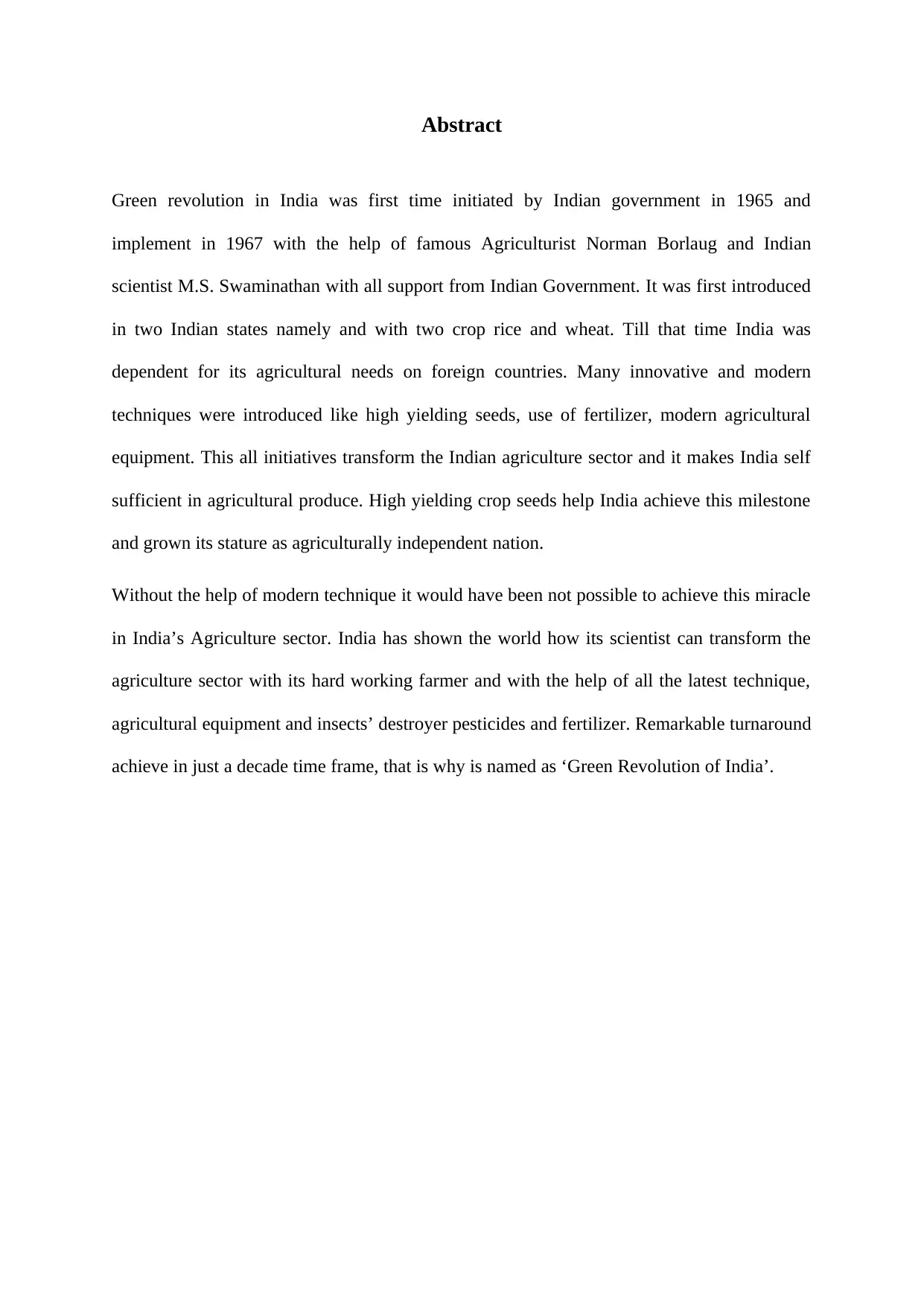
Abstract
Green revolution in India was first time initiated by Indian government in 1965 and
implement in 1967 with the help of famous Agriculturist Norman Borlaug and Indian
scientist M.S. Swaminathan with all support from Indian Government. It was first introduced
in two Indian states namely and with two crop rice and wheat. Till that time India was
dependent for its agricultural needs on foreign countries. Many innovative and modern
techniques were introduced like high yielding seeds, use of fertilizer, modern agricultural
equipment. This all initiatives transform the Indian agriculture sector and it makes India self
sufficient in agricultural produce. High yielding crop seeds help India achieve this milestone
and grown its stature as agriculturally independent nation.
Without the help of modern technique it would have been not possible to achieve this miracle
in India’s Agriculture sector. India has shown the world how its scientist can transform the
agriculture sector with its hard working farmer and with the help of all the latest technique,
agricultural equipment and insects’ destroyer pesticides and fertilizer. Remarkable turnaround
achieve in just a decade time frame, that is why is named as ‘Green Revolution of India’.
Green revolution in India was first time initiated by Indian government in 1965 and
implement in 1967 with the help of famous Agriculturist Norman Borlaug and Indian
scientist M.S. Swaminathan with all support from Indian Government. It was first introduced
in two Indian states namely and with two crop rice and wheat. Till that time India was
dependent for its agricultural needs on foreign countries. Many innovative and modern
techniques were introduced like high yielding seeds, use of fertilizer, modern agricultural
equipment. This all initiatives transform the Indian agriculture sector and it makes India self
sufficient in agricultural produce. High yielding crop seeds help India achieve this milestone
and grown its stature as agriculturally independent nation.
Without the help of modern technique it would have been not possible to achieve this miracle
in India’s Agriculture sector. India has shown the world how its scientist can transform the
agriculture sector with its hard working farmer and with the help of all the latest technique,
agricultural equipment and insects’ destroyer pesticides and fertilizer. Remarkable turnaround
achieve in just a decade time frame, that is why is named as ‘Green Revolution of India’.
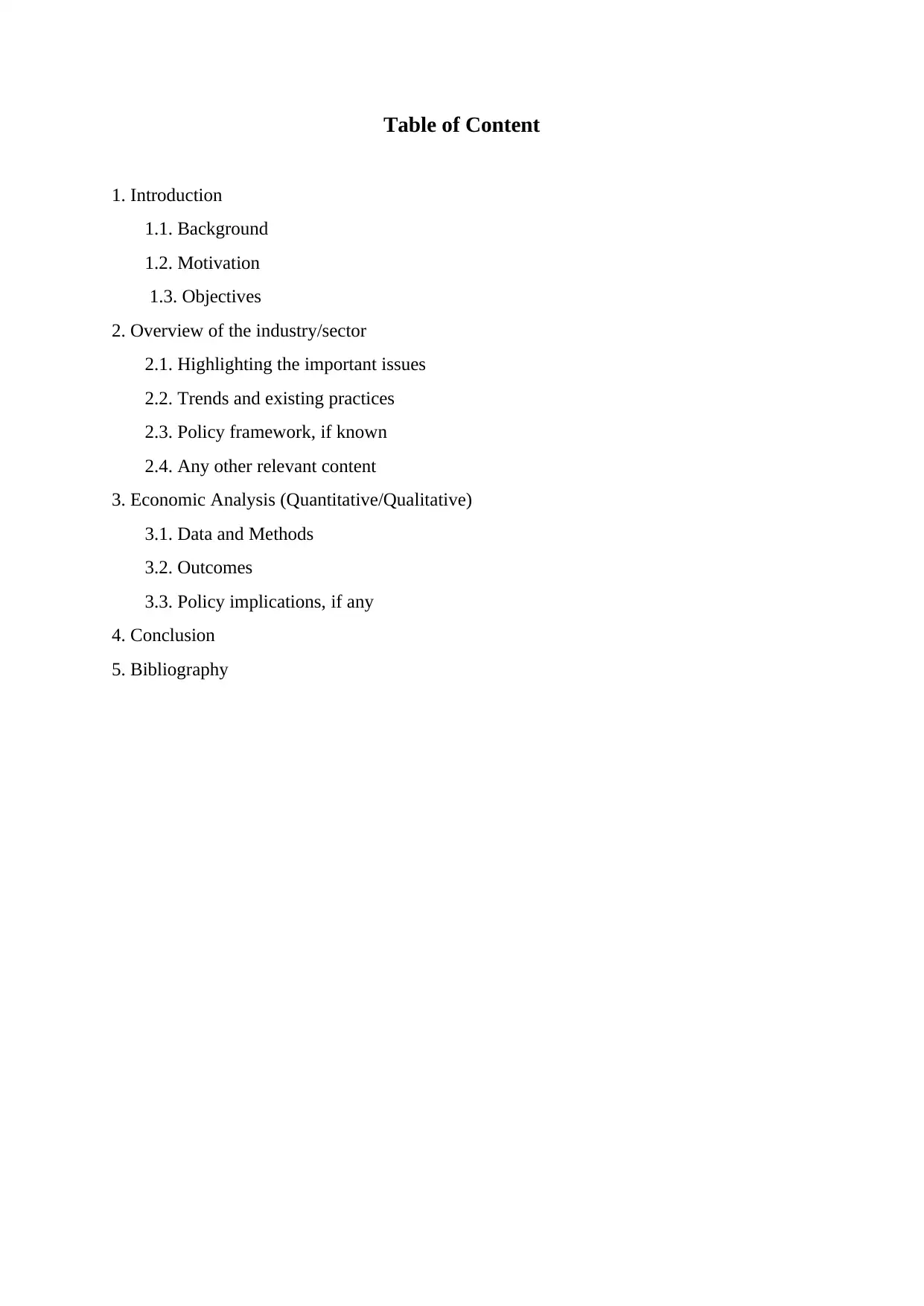
Table of Content
1. Introduction
1.1. Background
1.2. Motivation
1.3. Objectives
2. Overview of the industry/sector
2.1. Highlighting the important issues
2.2. Trends and existing practices
2.3. Policy framework, if known
2.4. Any other relevant content
3. Economic Analysis (Quantitative/Qualitative)
3.1. Data and Methods
3.2. Outcomes
3.3. Policy implications, if any
4. Conclusion
5. Bibliography
1. Introduction
1.1. Background
1.2. Motivation
1.3. Objectives
2. Overview of the industry/sector
2.1. Highlighting the important issues
2.2. Trends and existing practices
2.3. Policy framework, if known
2.4. Any other relevant content
3. Economic Analysis (Quantitative/Qualitative)
3.1. Data and Methods
3.2. Outcomes
3.3. Policy implications, if any
4. Conclusion
5. Bibliography
⊘ This is a preview!⊘
Do you want full access?
Subscribe today to unlock all pages.

Trusted by 1+ million students worldwide
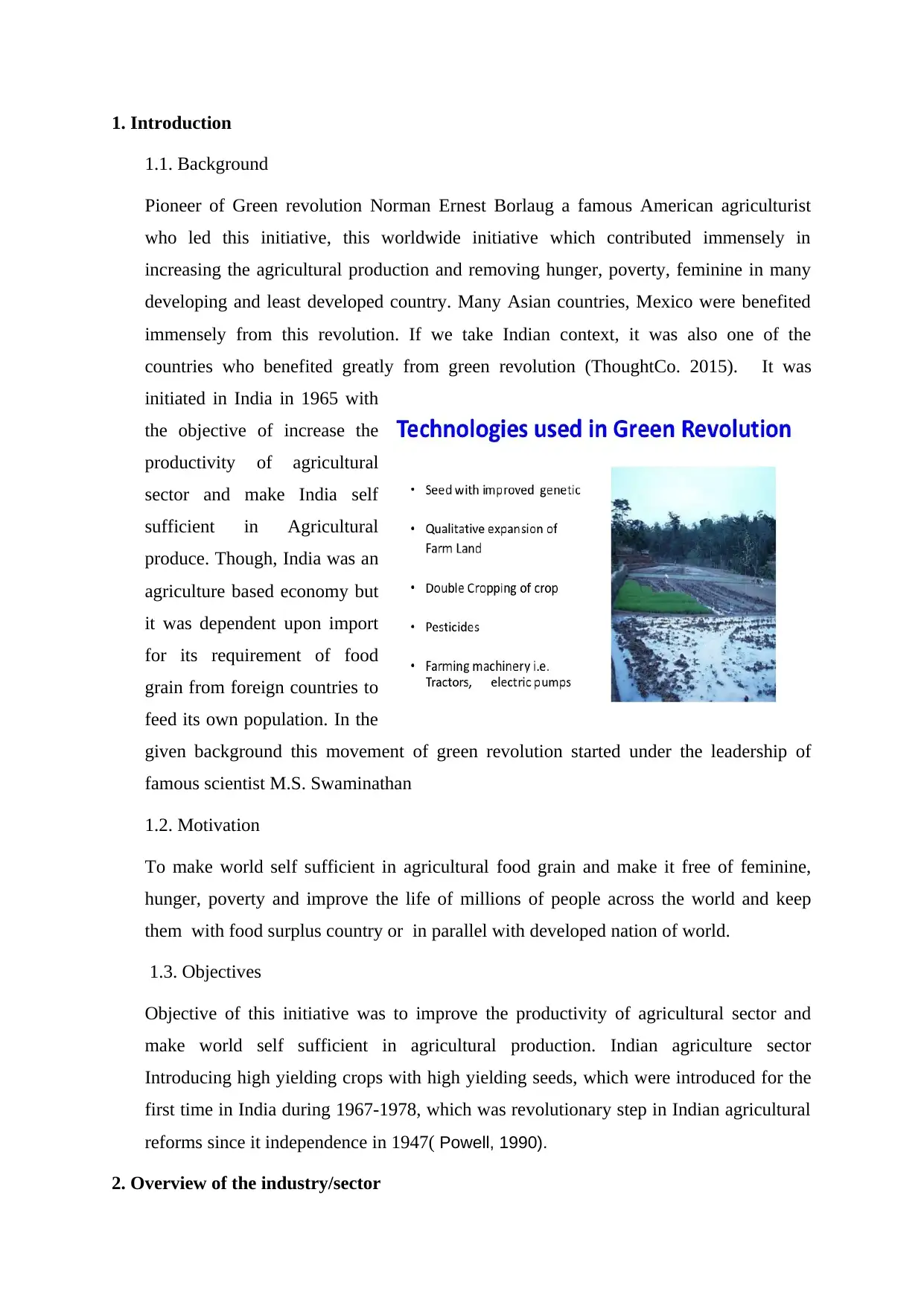
1. Introduction
1.1. Background
Pioneer of Green revolution Norman Ernest Borlaug a famous American agriculturist
who led this initiative, this worldwide initiative which contributed immensely in
increasing the agricultural production and removing hunger, poverty, feminine in many
developing and least developed country. Many Asian countries, Mexico were benefited
immensely from this revolution. If we take Indian context, it was also one of the
countries who benefited greatly from green revolution (ThoughtCo. 2015). It was
initiated in India in 1965 with
the objective of increase the
productivity of agricultural
sector and make India self
sufficient in Agricultural
produce. Though, India was an
agriculture based economy but
it was dependent upon import
for its requirement of food
grain from foreign countries to
feed its own population. In the
given background this movement of green revolution started under the leadership of
famous scientist M.S. Swaminathan
1.2. Motivation
To make world self sufficient in agricultural food grain and make it free of feminine,
hunger, poverty and improve the life of millions of people across the world and keep
them with food surplus country or in parallel with developed nation of world.
1.3. Objectives
Objective of this initiative was to improve the productivity of agricultural sector and
make world self sufficient in agricultural production. Indian agriculture sector
Introducing high yielding crops with high yielding seeds, which were introduced for the
first time in India during 1967-1978, which was revolutionary step in Indian agricultural
reforms since it independence in 1947( Powell, 1990).
2. Overview of the industry/sector
1.1. Background
Pioneer of Green revolution Norman Ernest Borlaug a famous American agriculturist
who led this initiative, this worldwide initiative which contributed immensely in
increasing the agricultural production and removing hunger, poverty, feminine in many
developing and least developed country. Many Asian countries, Mexico were benefited
immensely from this revolution. If we take Indian context, it was also one of the
countries who benefited greatly from green revolution (ThoughtCo. 2015). It was
initiated in India in 1965 with
the objective of increase the
productivity of agricultural
sector and make India self
sufficient in Agricultural
produce. Though, India was an
agriculture based economy but
it was dependent upon import
for its requirement of food
grain from foreign countries to
feed its own population. In the
given background this movement of green revolution started under the leadership of
famous scientist M.S. Swaminathan
1.2. Motivation
To make world self sufficient in agricultural food grain and make it free of feminine,
hunger, poverty and improve the life of millions of people across the world and keep
them with food surplus country or in parallel with developed nation of world.
1.3. Objectives
Objective of this initiative was to improve the productivity of agricultural sector and
make world self sufficient in agricultural production. Indian agriculture sector
Introducing high yielding crops with high yielding seeds, which were introduced for the
first time in India during 1967-1978, which was revolutionary step in Indian agricultural
reforms since it independence in 1947( Powell, 1990).
2. Overview of the industry/sector
Paraphrase This Document
Need a fresh take? Get an instant paraphrase of this document with our AI Paraphraser
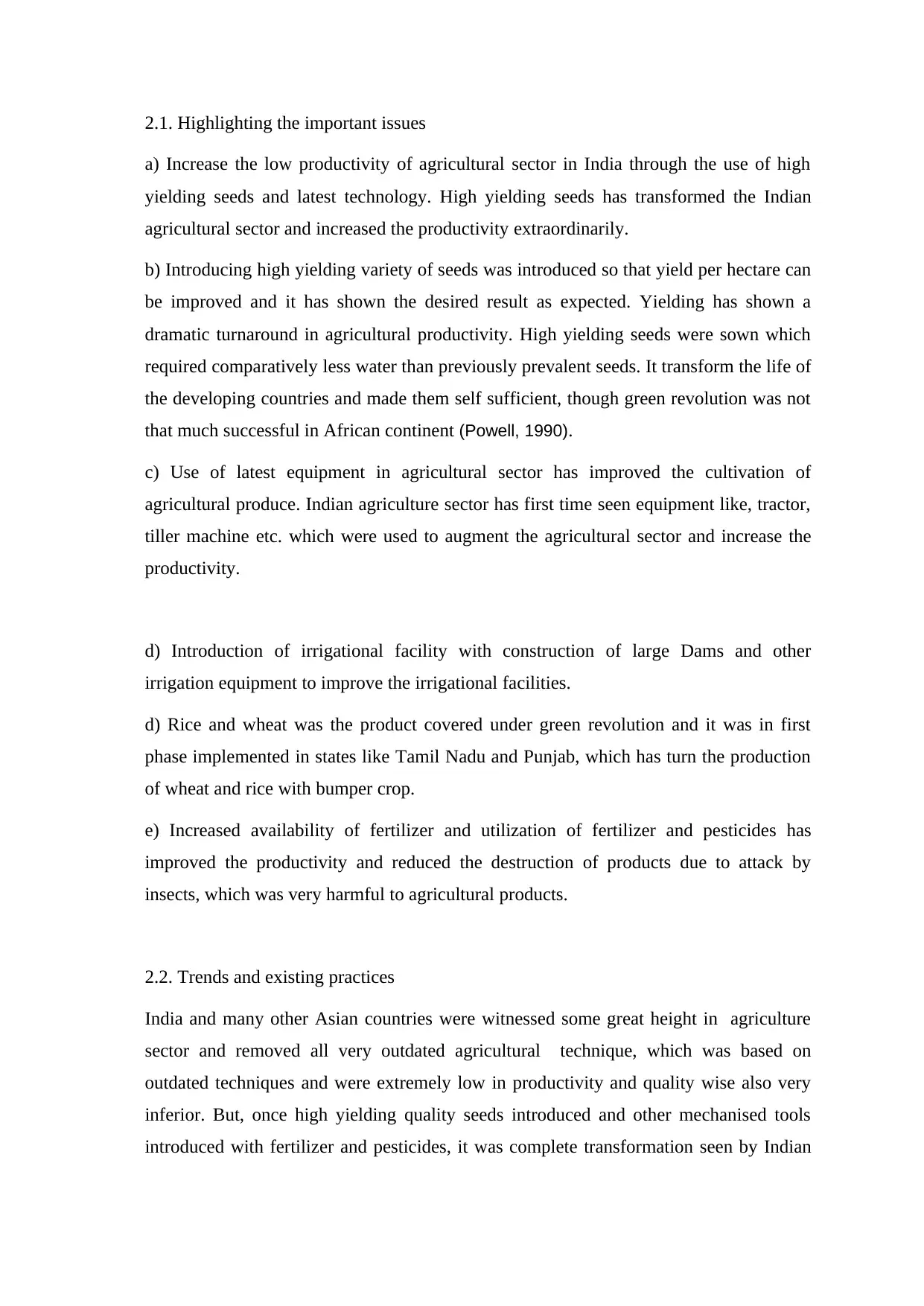
2.1. Highlighting the important issues
a) Increase the low productivity of agricultural sector in India through the use of high
yielding seeds and latest technology. High yielding seeds has transformed the Indian
agricultural sector and increased the productivity extraordinarily.
b) Introducing high yielding variety of seeds was introduced so that yield per hectare can
be improved and it has shown the desired result as expected. Yielding has shown a
dramatic turnaround in agricultural productivity. High yielding seeds were sown which
required comparatively less water than previously prevalent seeds. It transform the life of
the developing countries and made them self sufficient, though green revolution was not
that much successful in African continent (Powell, 1990).
c) Use of latest equipment in agricultural sector has improved the cultivation of
agricultural produce. Indian agriculture sector has first time seen equipment like, tractor,
tiller machine etc. which were used to augment the agricultural sector and increase the
productivity.
d) Introduction of irrigational facility with construction of large Dams and other
irrigation equipment to improve the irrigational facilities.
d) Rice and wheat was the product covered under green revolution and it was in first
phase implemented in states like Tamil Nadu and Punjab, which has turn the production
of wheat and rice with bumper crop.
e) Increased availability of fertilizer and utilization of fertilizer and pesticides has
improved the productivity and reduced the destruction of products due to attack by
insects, which was very harmful to agricultural products.
2.2. Trends and existing practices
India and many other Asian countries were witnessed some great height in agriculture
sector and removed all very outdated agricultural technique, which was based on
outdated techniques and were extremely low in productivity and quality wise also very
inferior. But, once high yielding quality seeds introduced and other mechanised tools
introduced with fertilizer and pesticides, it was complete transformation seen by Indian
a) Increase the low productivity of agricultural sector in India through the use of high
yielding seeds and latest technology. High yielding seeds has transformed the Indian
agricultural sector and increased the productivity extraordinarily.
b) Introducing high yielding variety of seeds was introduced so that yield per hectare can
be improved and it has shown the desired result as expected. Yielding has shown a
dramatic turnaround in agricultural productivity. High yielding seeds were sown which
required comparatively less water than previously prevalent seeds. It transform the life of
the developing countries and made them self sufficient, though green revolution was not
that much successful in African continent (Powell, 1990).
c) Use of latest equipment in agricultural sector has improved the cultivation of
agricultural produce. Indian agriculture sector has first time seen equipment like, tractor,
tiller machine etc. which were used to augment the agricultural sector and increase the
productivity.
d) Introduction of irrigational facility with construction of large Dams and other
irrigation equipment to improve the irrigational facilities.
d) Rice and wheat was the product covered under green revolution and it was in first
phase implemented in states like Tamil Nadu and Punjab, which has turn the production
of wheat and rice with bumper crop.
e) Increased availability of fertilizer and utilization of fertilizer and pesticides has
improved the productivity and reduced the destruction of products due to attack by
insects, which was very harmful to agricultural products.
2.2. Trends and existing practices
India and many other Asian countries were witnessed some great height in agriculture
sector and removed all very outdated agricultural technique, which was based on
outdated techniques and were extremely low in productivity and quality wise also very
inferior. But, once high yielding quality seeds introduced and other mechanised tools
introduced with fertilizer and pesticides, it was complete transformation seen by Indian
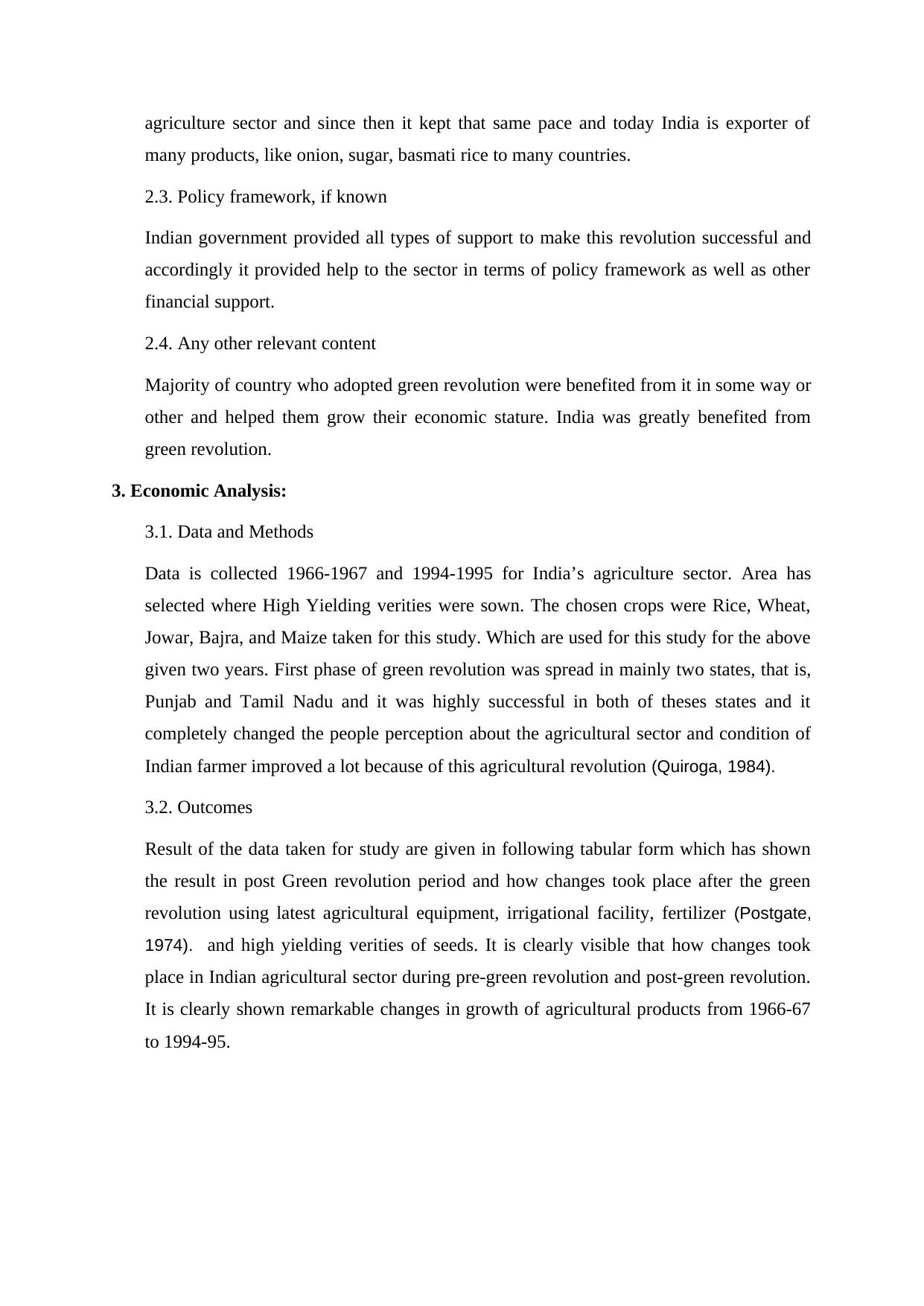
agriculture sector and since then it kept that same pace and today India is exporter of
many products, like onion, sugar, basmati rice to many countries.
2.3. Policy framework, if known
Indian government provided all types of support to make this revolution successful and
accordingly it provided help to the sector in terms of policy framework as well as other
financial support.
2.4. Any other relevant content
Majority of country who adopted green revolution were benefited from it in some way or
other and helped them grow their economic stature. India was greatly benefited from
green revolution.
3. Economic Analysis:
3.1. Data and Methods
Data is collected 1966-1967 and 1994-1995 for India’s agriculture sector. Area has
selected where High Yielding verities were sown. The chosen crops were Rice, Wheat,
Jowar, Bajra, and Maize taken for this study. Which are used for this study for the above
given two years. First phase of green revolution was spread in mainly two states, that is,
Punjab and Tamil Nadu and it was highly successful in both of theses states and it
completely changed the people perception about the agricultural sector and condition of
Indian farmer improved a lot because of this agricultural revolution (Quiroga, 1984).
3.2. Outcomes
Result of the data taken for study are given in following tabular form which has shown
the result in post Green revolution period and how changes took place after the green
revolution using latest agricultural equipment, irrigational facility, fertilizer (Postgate,
1974). and high yielding verities of seeds. It is clearly visible that how changes took
place in Indian agricultural sector during pre-green revolution and post-green revolution.
It is clearly shown remarkable changes in growth of agricultural products from 1966-67
to 1994-95.
many products, like onion, sugar, basmati rice to many countries.
2.3. Policy framework, if known
Indian government provided all types of support to make this revolution successful and
accordingly it provided help to the sector in terms of policy framework as well as other
financial support.
2.4. Any other relevant content
Majority of country who adopted green revolution were benefited from it in some way or
other and helped them grow their economic stature. India was greatly benefited from
green revolution.
3. Economic Analysis:
3.1. Data and Methods
Data is collected 1966-1967 and 1994-1995 for India’s agriculture sector. Area has
selected where High Yielding verities were sown. The chosen crops were Rice, Wheat,
Jowar, Bajra, and Maize taken for this study. Which are used for this study for the above
given two years. First phase of green revolution was spread in mainly two states, that is,
Punjab and Tamil Nadu and it was highly successful in both of theses states and it
completely changed the people perception about the agricultural sector and condition of
Indian farmer improved a lot because of this agricultural revolution (Quiroga, 1984).
3.2. Outcomes
Result of the data taken for study are given in following tabular form which has shown
the result in post Green revolution period and how changes took place after the green
revolution using latest agricultural equipment, irrigational facility, fertilizer (Postgate,
1974). and high yielding verities of seeds. It is clearly visible that how changes took
place in Indian agricultural sector during pre-green revolution and post-green revolution.
It is clearly shown remarkable changes in growth of agricultural products from 1966-67
to 1994-95.
⊘ This is a preview!⊘
Do you want full access?
Subscribe today to unlock all pages.

Trusted by 1+ million students worldwide
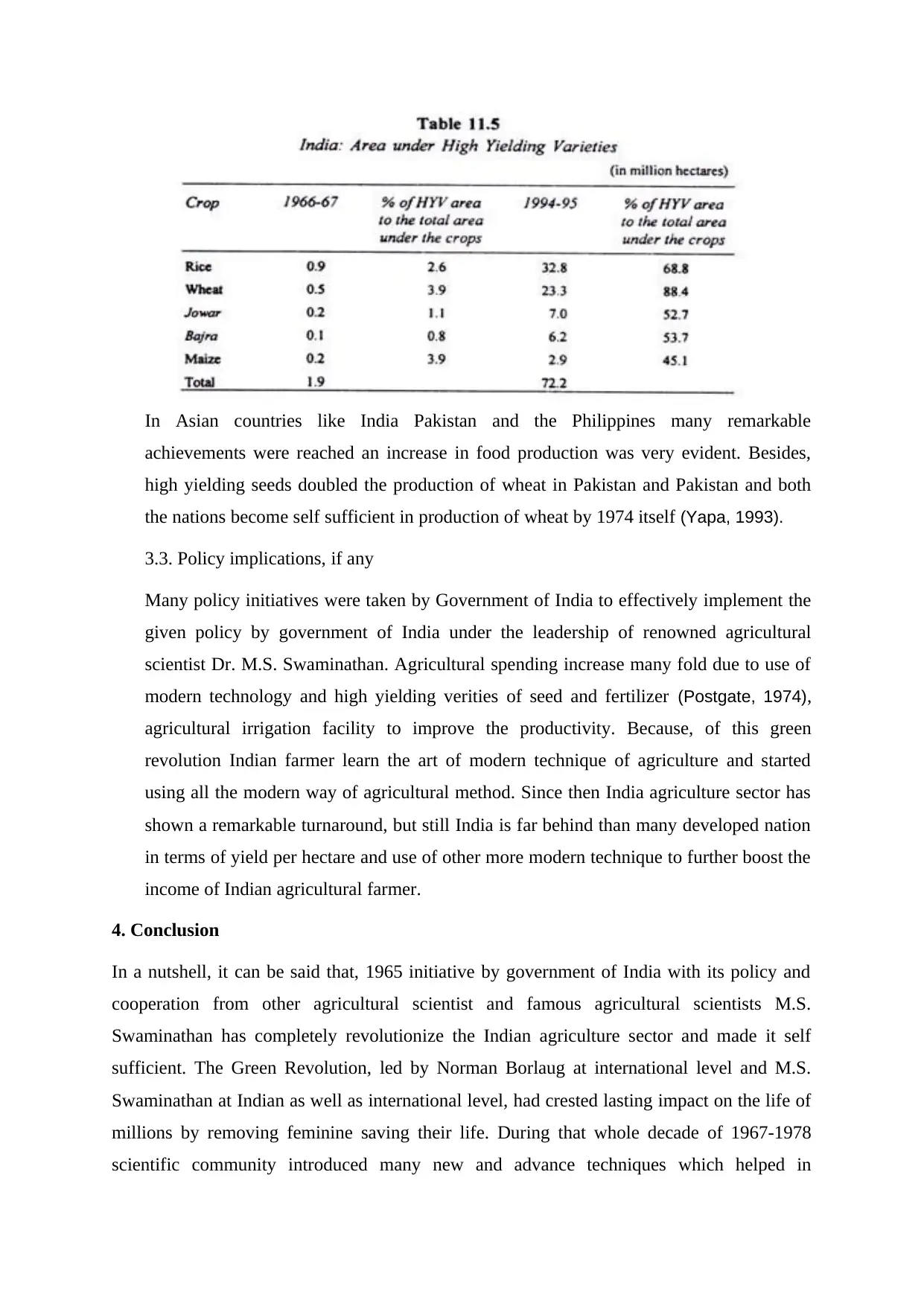
In Asian countries like India Pakistan and the Philippines many remarkable
achievements were reached an increase in food production was very evident. Besides,
high yielding seeds doubled the production of wheat in Pakistan and Pakistan and both
the nations become self sufficient in production of wheat by 1974 itself (Yapa, 1993).
3.3. Policy implications, if any
Many policy initiatives were taken by Government of India to effectively implement the
given policy by government of India under the leadership of renowned agricultural
scientist Dr. M.S. Swaminathan. Agricultural spending increase many fold due to use of
modern technology and high yielding verities of seed and fertilizer (Postgate, 1974),
agricultural irrigation facility to improve the productivity. Because, of this green
revolution Indian farmer learn the art of modern technique of agriculture and started
using all the modern way of agricultural method. Since then India agriculture sector has
shown a remarkable turnaround, but still India is far behind than many developed nation
in terms of yield per hectare and use of other more modern technique to further boost the
income of Indian agricultural farmer.
4. Conclusion
In a nutshell, it can be said that, 1965 initiative by government of India with its policy and
cooperation from other agricultural scientist and famous agricultural scientists M.S.
Swaminathan has completely revolutionize the Indian agriculture sector and made it self
sufficient. The Green Revolution, led by Norman Borlaug at international level and M.S.
Swaminathan at Indian as well as international level, had crested lasting impact on the life of
millions by removing feminine saving their life. During that whole decade of 1967-1978
scientific community introduced many new and advance techniques which helped in
achievements were reached an increase in food production was very evident. Besides,
high yielding seeds doubled the production of wheat in Pakistan and Pakistan and both
the nations become self sufficient in production of wheat by 1974 itself (Yapa, 1993).
3.3. Policy implications, if any
Many policy initiatives were taken by Government of India to effectively implement the
given policy by government of India under the leadership of renowned agricultural
scientist Dr. M.S. Swaminathan. Agricultural spending increase many fold due to use of
modern technology and high yielding verities of seed and fertilizer (Postgate, 1974),
agricultural irrigation facility to improve the productivity. Because, of this green
revolution Indian farmer learn the art of modern technique of agriculture and started
using all the modern way of agricultural method. Since then India agriculture sector has
shown a remarkable turnaround, but still India is far behind than many developed nation
in terms of yield per hectare and use of other more modern technique to further boost the
income of Indian agricultural farmer.
4. Conclusion
In a nutshell, it can be said that, 1965 initiative by government of India with its policy and
cooperation from other agricultural scientist and famous agricultural scientists M.S.
Swaminathan has completely revolutionize the Indian agriculture sector and made it self
sufficient. The Green Revolution, led by Norman Borlaug at international level and M.S.
Swaminathan at Indian as well as international level, had crested lasting impact on the life of
millions by removing feminine saving their life. During that whole decade of 1967-1978
scientific community introduced many new and advance techniques which helped in
Paraphrase This Document
Need a fresh take? Get an instant paraphrase of this document with our AI Paraphraser
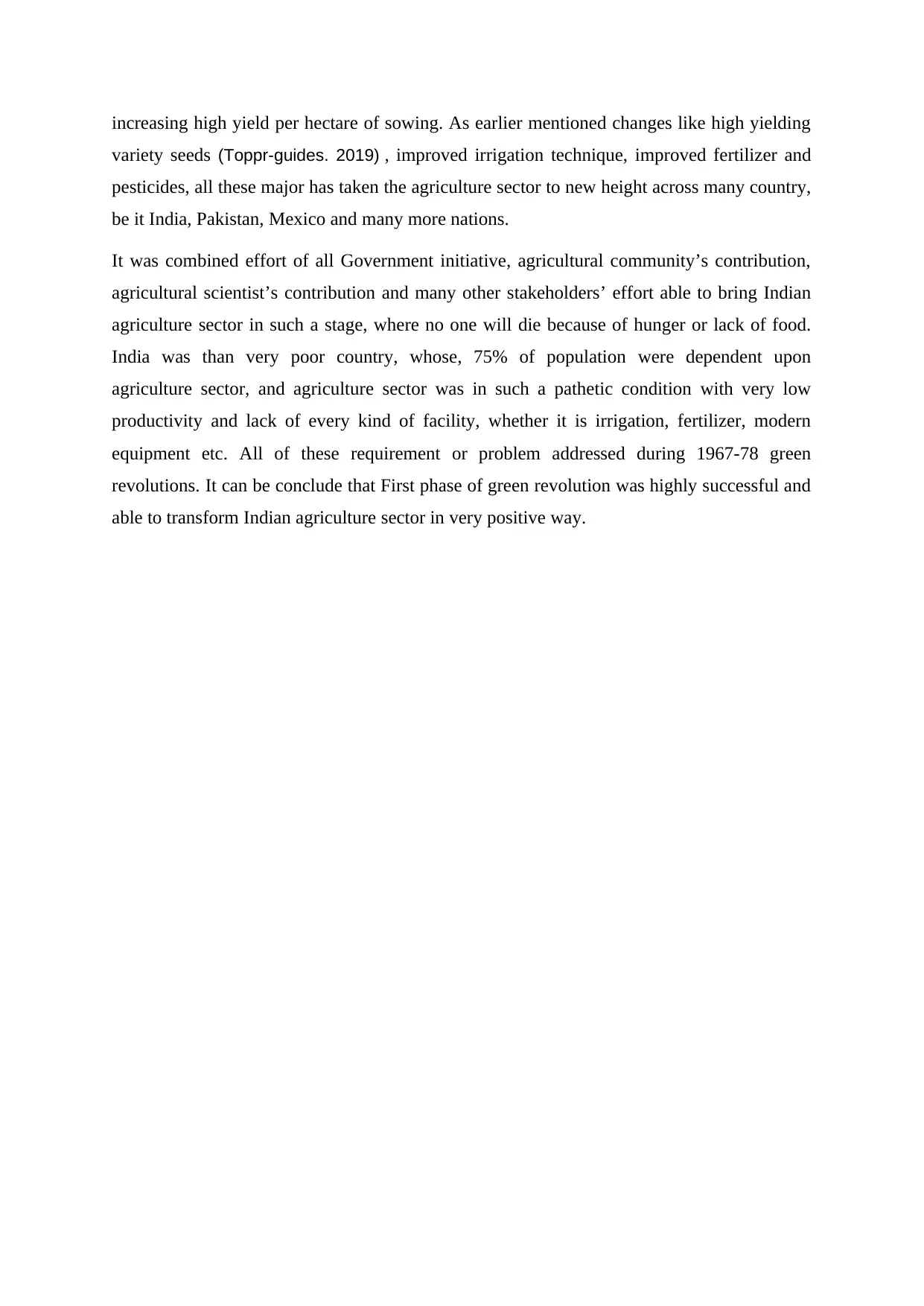
increasing high yield per hectare of sowing. As earlier mentioned changes like high yielding
variety seeds (Toppr-guides. 2019) , improved irrigation technique, improved fertilizer and
pesticides, all these major has taken the agriculture sector to new height across many country,
be it India, Pakistan, Mexico and many more nations.
It was combined effort of all Government initiative, agricultural community’s contribution,
agricultural scientist’s contribution and many other stakeholders’ effort able to bring Indian
agriculture sector in such a stage, where no one will die because of hunger or lack of food.
India was than very poor country, whose, 75% of population were dependent upon
agriculture sector, and agriculture sector was in such a pathetic condition with very low
productivity and lack of every kind of facility, whether it is irrigation, fertilizer, modern
equipment etc. All of these requirement or problem addressed during 1967-78 green
revolutions. It can be conclude that First phase of green revolution was highly successful and
able to transform Indian agriculture sector in very positive way.
variety seeds (Toppr-guides. 2019) , improved irrigation technique, improved fertilizer and
pesticides, all these major has taken the agriculture sector to new height across many country,
be it India, Pakistan, Mexico and many more nations.
It was combined effort of all Government initiative, agricultural community’s contribution,
agricultural scientist’s contribution and many other stakeholders’ effort able to bring Indian
agriculture sector in such a stage, where no one will die because of hunger or lack of food.
India was than very poor country, whose, 75% of population were dependent upon
agriculture sector, and agriculture sector was in such a pathetic condition with very low
productivity and lack of every kind of facility, whether it is irrigation, fertilizer, modern
equipment etc. All of these requirement or problem addressed during 1967-78 green
revolutions. It can be conclude that First phase of green revolution was highly successful and
able to transform Indian agriculture sector in very positive way.
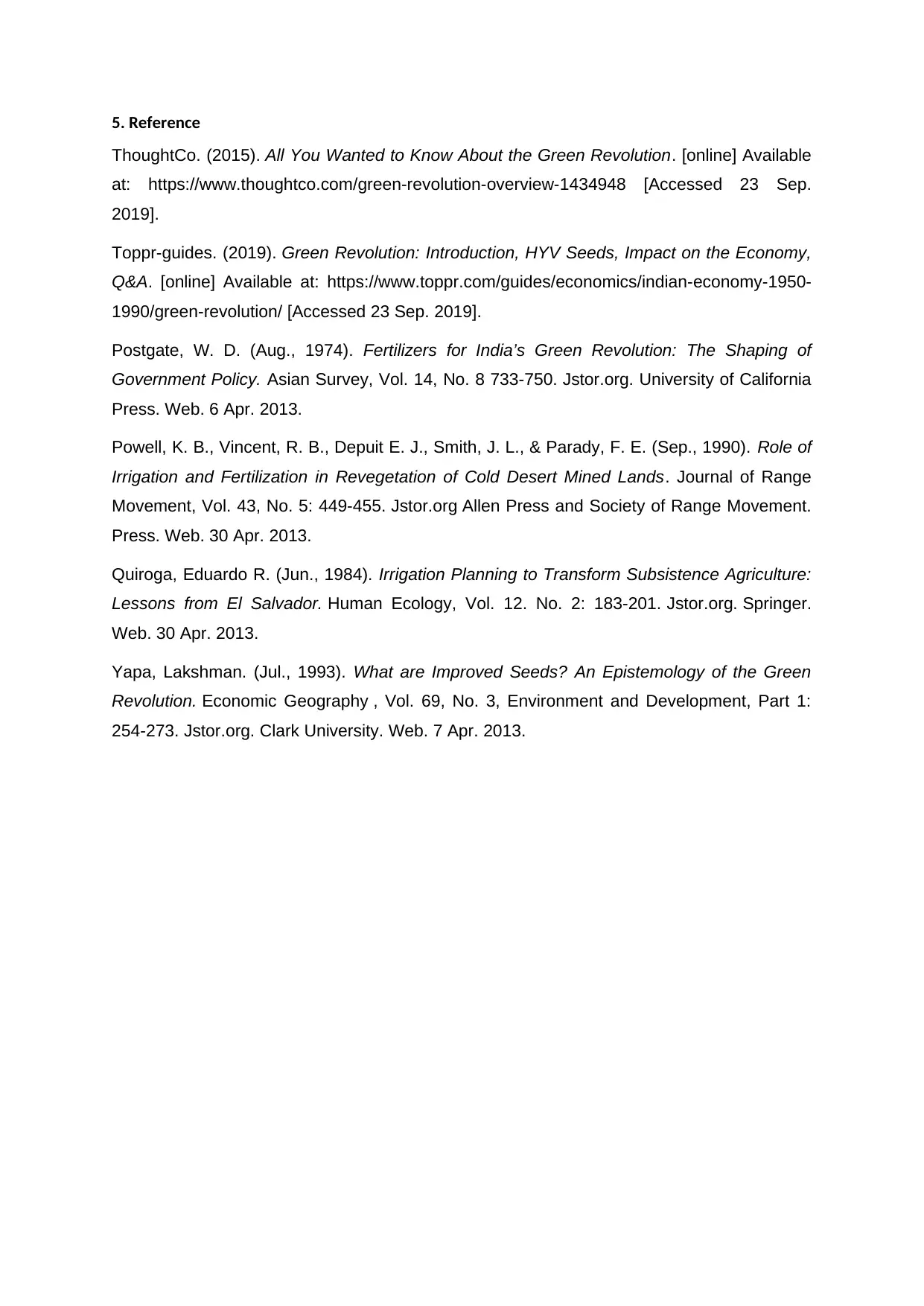
5. Reference
ThoughtCo. (2015). All You Wanted to Know About the Green Revolution. [online] Available
at: https://www.thoughtco.com/green-revolution-overview-1434948 [Accessed 23 Sep.
2019].
Toppr-guides. (2019). Green Revolution: Introduction, HYV Seeds, Impact on the Economy,
Q&A. [online] Available at: https://www.toppr.com/guides/economics/indian-economy-1950-
1990/green-revolution/ [Accessed 23 Sep. 2019].
Postgate, W. D. (Aug., 1974). Fertilizers for India’s Green Revolution: The Shaping of
Government Policy. Asian Survey, Vol. 14, No. 8 733-750. Jstor.org. University of California
Press. Web. 6 Apr. 2013.
Powell, K. B., Vincent, R. B., Depuit E. J., Smith, J. L., & Parady, F. E. (Sep., 1990). Role of
Irrigation and Fertilization in Revegetation of Cold Desert Mined Lands. Journal of Range
Movement, Vol. 43, No. 5: 449-455. Jstor.org Allen Press and Society of Range Movement.
Press. Web. 30 Apr. 2013.
Quiroga, Eduardo R. (Jun., 1984). Irrigation Planning to Transform Subsistence Agriculture:
Lessons from El Salvador. Human Ecology, Vol. 12. No. 2: 183-201. Jstor.org. Springer.
Web. 30 Apr. 2013.
Yapa, Lakshman. (Jul., 1993). What are Improved Seeds? An Epistemology of the Green
Revolution. Economic Geography , Vol. 69, No. 3, Environment and Development, Part 1:
254-273. Jstor.org. Clark University. Web. 7 Apr. 2013.
ThoughtCo. (2015). All You Wanted to Know About the Green Revolution. [online] Available
at: https://www.thoughtco.com/green-revolution-overview-1434948 [Accessed 23 Sep.
2019].
Toppr-guides. (2019). Green Revolution: Introduction, HYV Seeds, Impact on the Economy,
Q&A. [online] Available at: https://www.toppr.com/guides/economics/indian-economy-1950-
1990/green-revolution/ [Accessed 23 Sep. 2019].
Postgate, W. D. (Aug., 1974). Fertilizers for India’s Green Revolution: The Shaping of
Government Policy. Asian Survey, Vol. 14, No. 8 733-750. Jstor.org. University of California
Press. Web. 6 Apr. 2013.
Powell, K. B., Vincent, R. B., Depuit E. J., Smith, J. L., & Parady, F. E. (Sep., 1990). Role of
Irrigation and Fertilization in Revegetation of Cold Desert Mined Lands. Journal of Range
Movement, Vol. 43, No. 5: 449-455. Jstor.org Allen Press and Society of Range Movement.
Press. Web. 30 Apr. 2013.
Quiroga, Eduardo R. (Jun., 1984). Irrigation Planning to Transform Subsistence Agriculture:
Lessons from El Salvador. Human Ecology, Vol. 12. No. 2: 183-201. Jstor.org. Springer.
Web. 30 Apr. 2013.
Yapa, Lakshman. (Jul., 1993). What are Improved Seeds? An Epistemology of the Green
Revolution. Economic Geography , Vol. 69, No. 3, Environment and Development, Part 1:
254-273. Jstor.org. Clark University. Web. 7 Apr. 2013.
⊘ This is a preview!⊘
Do you want full access?
Subscribe today to unlock all pages.

Trusted by 1+ million students worldwide
1 out of 9
Your All-in-One AI-Powered Toolkit for Academic Success.
+13062052269
info@desklib.com
Available 24*7 on WhatsApp / Email
![[object Object]](/_next/static/media/star-bottom.7253800d.svg)
Unlock your academic potential
Copyright © 2020–2025 A2Z Services. All Rights Reserved. Developed and managed by ZUCOL.

